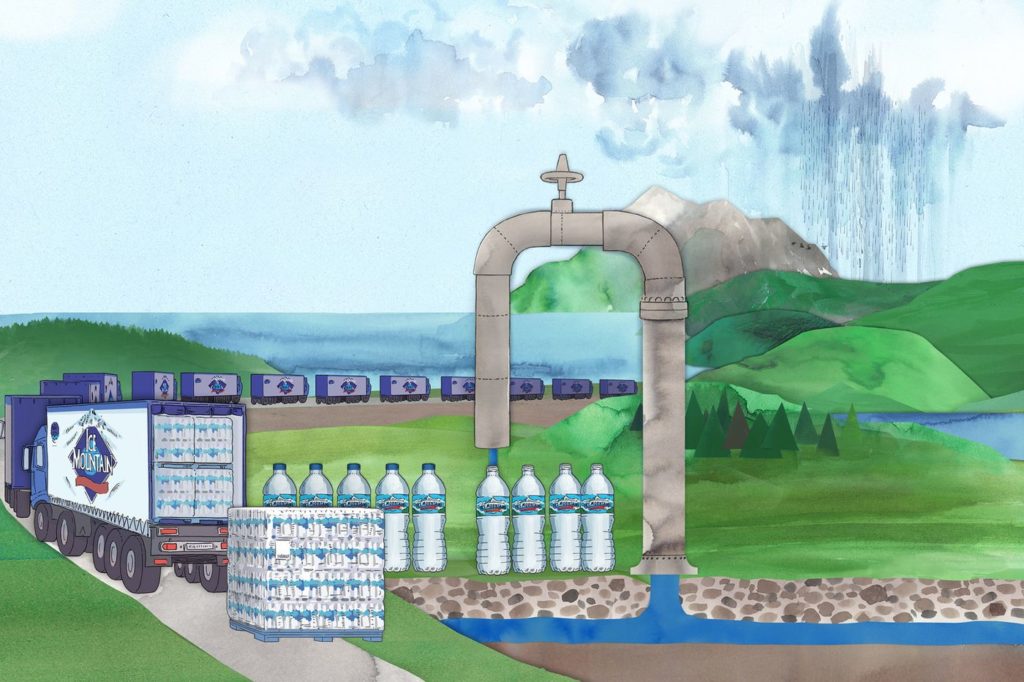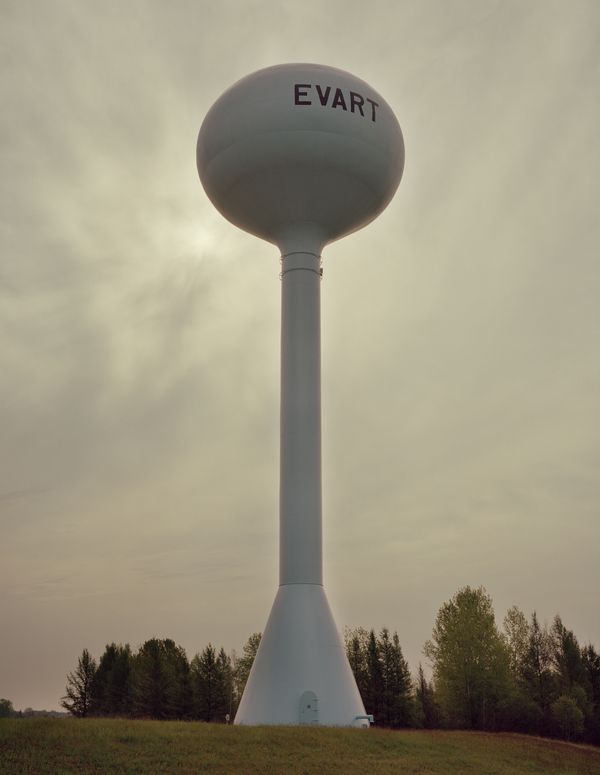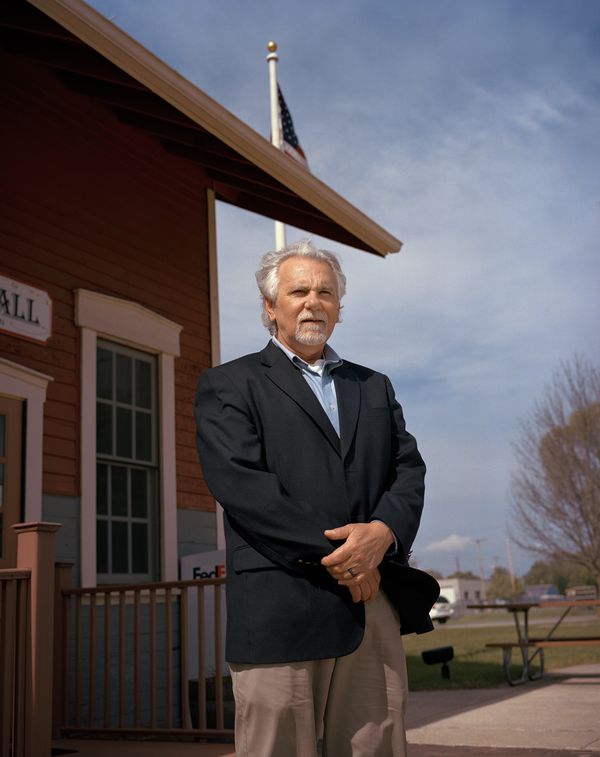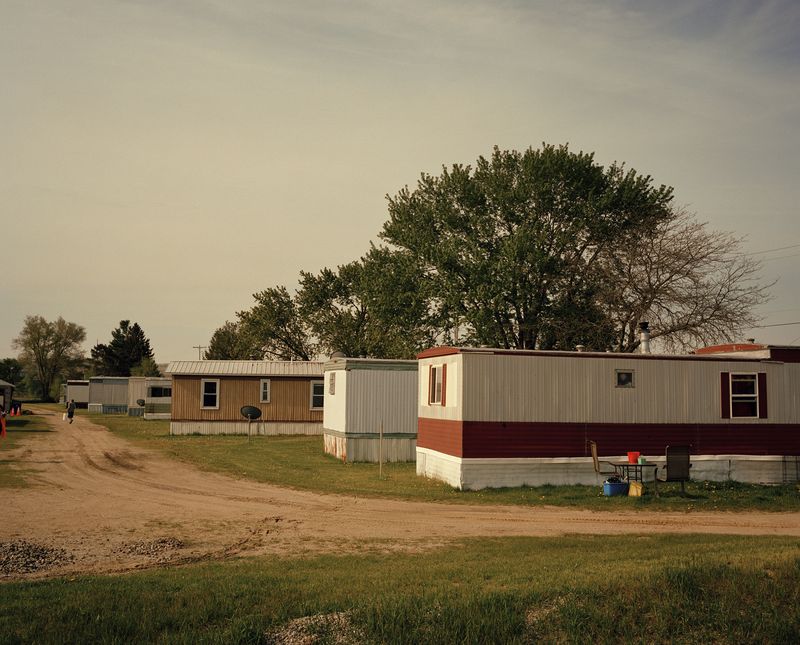Nestlé Makes Billions Bottling Water It Pays Nearly Nothing For
HEALTH, CAPITALISM, ECONOMICS, 25 Sep 2017
Caroline Winter | Bloomberg – TRANSCEND Media Service
The company’s operation in Michigan reveals how it’s dominated the industry by going into economically depressed areas with lax water laws.
21 Sep 2017 – In rural Mecosta County, Mich., sits a near-windowless facility with a footprint about the size of Buckingham Palace. It’s just one of Nestlé’s roughly 100 bottled water factories in 34 countries around the world.
Inside, workers wear hairnets, hard hats, goggles, gloves, and earplugs. Ten production lines snake through the space, funneling local spring water into 8-ounce to 2.5-gallon containers; most of the lines run 24/7, each pumping out 500 to 1,200 bottles per minute. About 60 percent of the supply comes from Mecosta’s springs and arrives at the factory via a 12-mile pipeline. The rest is trucked in from neighboring Osceola County, about 40 miles north. “Daily, we’re looking at 3.5 million bottles potentially,” says Dave Sommer, the plant’s 41-year-old manager, shouting above the din.
Silos holding 125 tons of plastic resin pellets provide the raw material for the bottles. They’re molded into shape at temperatures reaching 400F before being filled, capped, inspected, labeled, and laser-printed with the location, day, and minute they were produced—a process that takes less than 25 seconds. Next, the bottles are bundled, shrink-wrapped onto pallets, and picked up by a fleet of 25 forklifts that ferry them to the plant’s warehouse or loading docks. As many as 175 trucks arrive every day to transport the water to retail locations in the Midwest. “We want more people to drink water, keep hydrated,” Sommer says. “It would be nice if it were my water, but we just want them to drink water.”
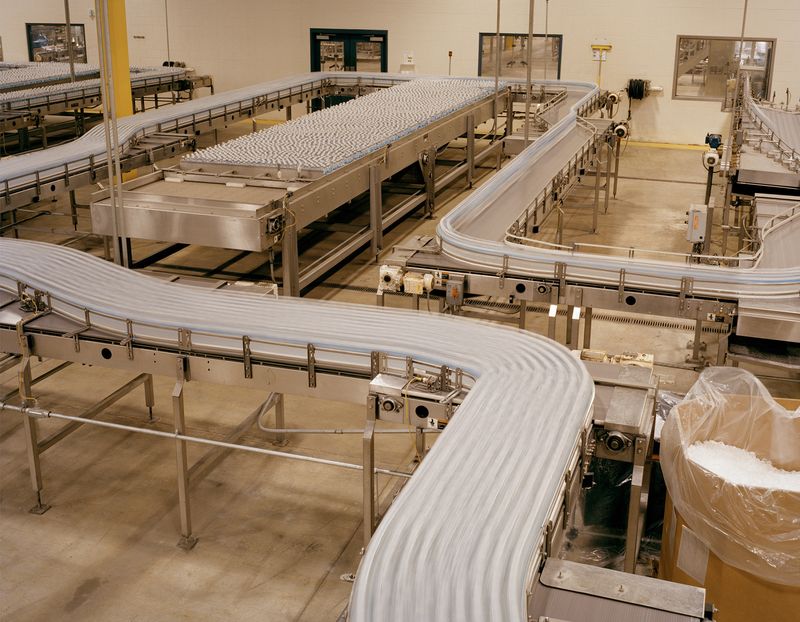
Water bottles in motion at the Nestlé Ice Mountain facility in Stanwood, Mich.
Photographer: Brendan George Ko for Bloomberg Businessweek
Nestlé SA started bottling in 1843 when company founder Henri Nestlé purchased a business on Switzerland’s Monneresse Canal. “Ever the curious scientist, [he] analyzed and experimented with the enrichment of water with a variety of minerals, always with a singular goal: to provide healthy, accessible, and delicious refreshment,” reads Nestlé’s website. Today there are thousands of bottled water companies worldwide—there’s even Trump Ice—but Nestlé is the biggest globally in terms of sales, followed by Coca-Cola, Danone, and PepsiCo, according to Euromonitor International. Nestlé Waters, the Paris-based subsidiary, owns almost 50 brands, including Perrier, S.Pellegrino, and Poland Spring.
Last year, U.S. bottled water sales reached $16 billion, up nearly 10 percent from 2015, according to Beverage Marketing Corp. They outpaced soda sales for the first time as drinkers continue to seek convenience and healthier options and worry about the safety of tap water after the high-profile contamination in Flint, Mich., about a two-hour drive from Mecosta. Nestlé alone sold $7.7 billion worth worldwide, with more than $343 million of it coming from Michigan, where the company bottles Ice Mountain Natural Spring Water and Pure Life, its purified water line.
The Michigan operation is only one small part of Nestlé, the world’s largest food and beverage company. But it illuminates how Nestlé has come to dominate a controversial industry, spring by spring, often going into economically depressed municipalities with the promise of jobs and new infrastructure in exchange for tax breaks and access to a resource that’s scarce for millions. Where Nestlé encounters grass-roots resistance against its industrial-strength guzzling, it deploys lawyers; where it’s welcome, it can push the limits of that hospitality, sometimes with the acquiescence of state and local governments that are too cash-strapped or inept to say no. There are the usual costs of doing business, including transportation, infrastructure, and salaries. But Nestlé pays little for the product it bottles—sometimes a municipal rate and other times just a nominal extraction fee. In Michigan, it’s $200.
The Romans were among the first to see water as more than a basic need. They ranked theirs by taste; Aqua Marcia, from a spring about 60 miles outside of Rome, was among the best. In the 19th century, some of the first mass-market brands were S.Pellegrino and Vittel, now owned by Nestlé, and Evian, a Danone label. Sales were driven by taste, as well as the age-old notion that the mineral contents are therapeutic, curing ailments from hangovers to kidney stones. But mineral water consumption in America cratered in the early 20th century in part because the U.S. Food and Drug Administration made it harder to tout medicinal benefits without expensive testing.
Today, Americans often drink bottled water for what they hope is not in it. Fears about what comes out of the tap aren’t completely unfounded; 77 million Americans are served by water systems that violate testing requirements or rules about contamination in drinking water, according to the Natural Resources Defense Council. In agriculture-heavy regions, pesticides, fertilizers, and nitrates from animal waste leach into the ground. Despite the Safe Drinking Water Act of 1974, compliance with harmful chemical restrictions isn’t monitored carefully, and most wastewater-treatment systems aren’t designed to remove hormones, antidepressants, and other drugs. The Trump administration’s Environmental Protection Agency is also attempting to roll back existing regulations. That said, bottled water isn’t necessarily more pure than tap. In the U.S., municipalities with 2.5 million or more people are required to test their supply dozens of times each day, whereas those with fewer than 50,000 customers must test for certain contaminants 60 times per month. Bottled water companies aren’t required to monitor their reserve or report contamination, although Nestlé says it tests its water hourly.
There’s also the issue of scarcity. The United Nations expects that 1.8 billion people will live in places with dire water shortages by 2025, and two-thirds of the world’s population could be living under stressed water conditions. Supply may be compromised in the U.S., too. A recent Michigan State University study predicts that more than a third of Americans might not be able to afford their water bills in five years, with costs expected to triple as World War II-era construction breaks down.
Failing infrastructure has already led to a near-total reliance on bottled water in parts of the world. Nestlé started selling Pure Life in Lahore, Pakistan, in 1998 to “provide a safe, quality water solution,” the company says. But locals wonder if the Swiss multinational is exacerbating the problem. “Twenty years ago, you could go anywhere in Lahore and get a glass of clean tap water for free,” says Ahmad Rafay Alam, an environmental lawyer in the country. “Now, everyone drinks bottled water.” He adds that this change has taken the pressure off the government to fix its utilities, degrading the quality of Lahore’s supply: “What Nestlé did is use a good marketing scheme to make tap water uncool and dangerous. It’s ubiquitous, like Kleenex. People will say, ‘Give me a bottle of Nestlé.’ ”
Nestlé has been preparing for shortages for decades. The company’s former chief executive officer, Helmut Maucher, said in a 1994 interview with the New York Times: “Springs are like petroleum. You can always build a chocolate factory. But springs you have or you don’t have.” His successor, Peter Brabeck-Letmathe, who retired recently after 21 years in charge, drew criticism for encouraging the commodification of water in a 2005 documentary, saying: “One perspective held by various NGOs—which I would call extreme—is that water should be declared a human right. … The other view is that water is a grocery product. And just as every other product, it should have a market value.” Public outrage ensued. Brabeck-Letmathe says his comments were taken out of context and that water is a human right. He later proposed that people should have free access to 30 liters per day, paying only for additional use.
Compared with the water needs of agriculture and energy production, the bottled water business is barely responsible for a trickle; in Michigan, it accounts for less than 1 percent of total water usage, according to Michigan’s Department of Environmental Quality (DEQ). But it rankles many because the natural resource gets hauled out of local watersheds for private profit, not used in the service of feeding people or keeping their lights on. There’s also, of course, the issue of plastic pollution.
In the U.S., Nestlé tends to set up shop in areas with weak water regulations or lobbies to enfeeble laws. States such as Maine and Texas operate under a remarkably lax rule from the 1800s called “absolute capture,” which lets landowners take all the groundwater they want. Michigan, New York, and other states have stricter laws, allowing “reasonable use,” which means property owners can extract water as long as it doesn’t unreasonably affect other wells or the aquifer system. Laws vary even within states. New Hampshire is a reasonable-use state, but in 2006, the municipality of Barnstead became the first nationwide to ban the pumping of its water for sale elsewhere.
Towns in Oregon, Pennsylvania, and Wisconsin have turned away Nestlé. In Washington, the mayor of Waitsburg, Walt Gobel, resigned last year after it was revealed that he’d conducted secret talks with the company about building a $50 million plant. “The representatives asked for confidentiality of this proposal until they could determine the feasibility,” Gobel wrote in his resignation letter. Town leaders later voted to reject Nestlé’s advances.
Elsewhere, Nestlé has largely prevailed against opposition. In Fryeburg, Maine, it took the company four years to successfully appeal a zoning board resolution to build a facility it said it needed for its Poland Spring line. Last year it gained rights to extract water for the next 20 years—and perhaps 25 more after that. In San Bernardino, Calif., Nestlé has long paid the U.S. Forest Service an annual rate of $524 to extract about 30 million gallons, even during droughts. “Our public agencies have dropped the ball,” says Peter Gleick, co-founder of the Pacific Institute, which focuses on water issues. “Every gallon of water that is taken out of a natural system for bottled water is a gallon of water that doesn’t flow down a stream, that doesn’t support a natural ecosystem,” he says.
Nestlé isn’t the only bottled water company operating in Michigan, but it’s the most controversial. Pepsi and Coca-Cola bottle municipal water from Detroit for their Aquafina and Dasani brands, respectively; they pay city rates, then sell the product back for profit. In Mecosta County, Nestlé sucks up spring water directly from the source, which water conservationists say does more damage to the flow of streams, rivers, and wetland ecology. Municipal supplies come from larger bodies of water, so massive depletions, they argue, have less of an impact. Nestlé’s chief of sustainability, Nelson Switzer, responds: “Water is a renewable resource. As long as you manage the area, water will flow in perpetuity.”
Nestlé purchased Ice Mountain from Pepsi in 2000 and moved the production facilities from the East Coast to mountain-less Mecosta. State and local officials appreciated the business and offered a $13 million, one-time tax break. When people found out that Nestlé was pumping water in their backyards, however, they formed an opposition group, Michigan Citizens for Water Conservation. Spearheaded by retired librarians and teachers, the group added more than 2,000 members statewide, enlisted the land-and-water-rights lawyer Jim Olson, and filed a lawsuit to stop Nestlé.
The case dragged on for eight years and cost the group more than $1 million. To raise money, it charged membership fees and threw fundraisers. “Garage sales twice a year, Texas Hold ’em, raffles, a few grants from nonprofits,” says President Peggy Case, a retired schoolteacher who rigged her own water towers to irrigate the gardens on her 35-acre property.
In 2003 a judge ruled against Nestlé, saying that data documenting three years of extraction by the company showed a significant depletion of the area’s streams and wetlands. Nestlé appealed, and the case lasted six more years before the two parties settled in 2009. Nestlé would reduce pumping from 400 gallons per minute to 218, with further restrictions in spring and summer, which residents hoped would limit the environmental impact.
Even before the settlement, Nestlé had expanded its operation beyond Mecosta County to neighboring Osceola County. For access to municipal wells in the city of Evart and one nonmunicipal well nearby, the company promised to fund 14 acres of new softball fields, plus a bullpen and lockers, for the high school team. The school superintendent, Howard Hyde, told the Grand Rapids Press in March 2005: “I’m tickled. It’s like Christmas. Our current fields are pretty nice, but these are going to be better.”
More than 44 percent of Evart’s 1,500 residents live below the poverty line, according to Data USA. Officials were disappointed that Nestlé built its Ice Mountain plant in Mecosta, which cost the city 280 jobs, but they were grateful for the roughly $250,000 Nestlé pays Evart annually for its water. “[If they left], our services would decline,” says Zackary Szakacs, the city manager.
In addition to the softball fields, Nestlé has helped Evart finance other upgrades, including new well houses for its municipal water, parks, and a fairground that hosts a dulcimer festival in July. For decades the fairground was also home to Evart’s Fourth of July fireworks celebration, attended by as many as 10,000 locals. In 2015, Nestlé discovered contamination in the watershed from perchlorate in those fireworks. The likely carcinogen is banned at certain levels only in Massachusetts and California, which is why Evart hadn’t been testing for it. But because Nestlé sells in all 50 states, says Szakacs, none of its water can test positive for the chemical. The company has since stopped pumping from affected wells and spent hundreds of thousands of dollars to clean them up.
At 58, Szakacs has snow-white hair, a goatee, a gruff voice, and a love of fishing and Coors Light. A former policeman, he’d moved to Evart in 2006 to be chief. His office at Evart City Hall is within walking distance of the pumping station where a steady stream of 12,500-gallon trucks arrive each day to pick up water for the Ice Mountain factory. Szakacs isn’t worried about Evart’s springs. “Look, we’ve got plenty of water, more water than you can imagine,” he says. “We’ve got rivers, and streams, and fish—bass, trout.”
Last Halloween, however, Garret Ellison, an environmental reporter for MLive and the Grand Rapids Press, discovered that Nestlé had applied for a permit to more than double its pumping rate at the well near Evart, to 400 gallons per minute—the same rate that was ruled harmful in Mecosta. Anticipating approval, Nestlé had invested $36 million to build an 80,000-square-foot addition to its Ice Mountain plant and applied for another permit for a booster station to help pump the additional flow. Michigan’s DEQ had all but approved the application for the increased pumping rate without allowing for a period of public comment.
After Ellison’s story went live, the department received more than 1,100 emails in three days (the number is now 81,000). “It sent a shock wave through most communities in Michigan,” says Olson, the lawyer, who filed an injunction with the nonprofit rights group For Love of Water demanding that the department extend its comment period and release relevant documents for review. Nestlé now awaits a decision on whether it will be allowed to increase pumping at the well near Evart. In late July the DEQ asked the company to produce data showing that higher pumping rates wouldn’t damage the environment, numbers that Nestlé plans to submit on Sept. 29.
Arlene Anderson-Vincent, a natural resource manager for Nestlé, says the uptick won’t damage the ecosystem. “The water here is constantly being replenished, much more quickly than we can pump,” says Anderson-Vincent, who was born and raised in Michigan and got a bachelor’s degree in geology from Michigan State University while working at General Motors as a welder. Nestlé has collected 17 years’ worth of data evaluating groundwater levels and stream flow—and although, she concedes, the wetlands in Mecosta might not have withstood 400 gallons per minute, Evart’s can. “Every well is different,” she says.
Nestlé’s data doesn’t make “reliable assumptions about real world conditions,” says Olson. “We know our glacial soils in Michigan, and we know our vegetation. You can pretty much take the old case [in Mecosta] as a predictor” of environmental impact.
Six months after Ellison’s reporting, on a chilly evening in April, more than 500 people filed into a large auditorium at Ferris State University near the Ice Mountain plant. They’d come from all across Michigan to take part in the DEQ’s public hearing on Nestlé, but they had more on their mind than Evart. “We took a bus here from Flint because we’re tired of bottled water, tired of Nestlé, tired of them making a profit off of our disaster,” said Bernadel Jefferson, a pastor and activist who arrived with a dozen other protesters.
It’s impossible to talk about water in Michigan without raising the crisis in Flint. Beginning in 2014 thousands of families were exposed to dangerous levels of lead and bacteria in tap water. Michigan Governor Rick Snyder cut costs by switching the city’s water source, after which the state failed to properly treat the water with anticorrosives. An outbreak of Legionnaires’ disease killed at least 12 people and led to manslaughter charges against five state and city officials. Snyder also tried, unsuccessfully, to block a federal court order forcing the state to deliver bottled water to residents. He argued that, at an estimated $10.5 million a month, it would be too costly, put more trucks on the road, and overwhelm Flint’s recycling system.
Nestlé is quick to point out that it has nothing to do with the water problems in Flint or elsewhere. “What happened in Flint, and what’s happening in other communities in the United States, is absolutely outrageous,” says Switzer, the sustainability chief. Nestlé even teamed up with Wal-Mart, Coca-Cola, and Pepsi to donate 35,000 bottles per month to Flint residents—“for schoolchildren,” he says.
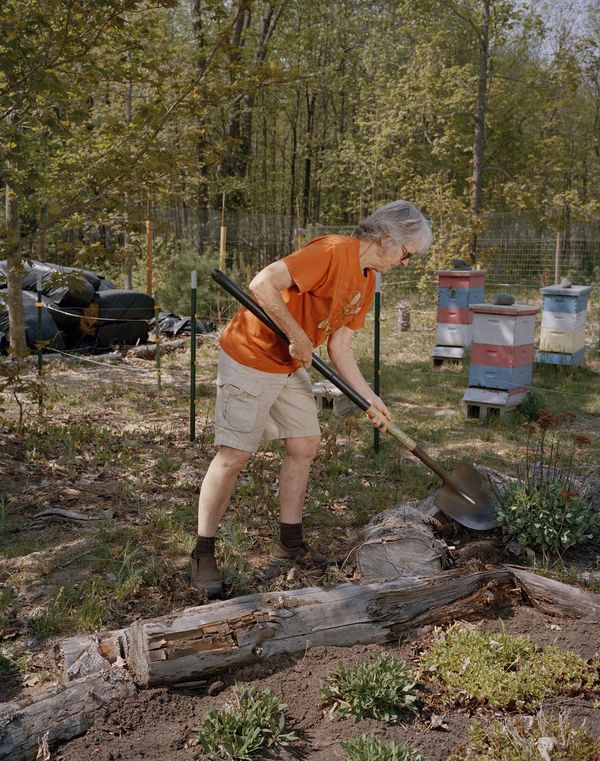
Case, president of Michigan Citizens for Water Conservation.
Photographer: Brendan George Ko for Bloomberg Businessweek
But since the crisis, Flint residents have paid thousands of dollars to purchase bottled water for drinking, cooking, washing, and bathing. “Between 2005 and 2016, Nestlé has taken over 4 billion gallons of our water for pennies and sold it back to us for huge profits,” said Case, the opposition group president, the first of about 50 people to speak at the hearing. “Meanwhile, the people of Flint have been forced to use this bottled water for several years and are required to pay some of the highest water bills in the country for undrinkable water. The people of Detroit have experienced massive shutoffs since 2014, with up to 90,000 people shut off at times. If Detroiters could pay Nestlé rates, few would owe more than a dollar, and the majority would owe less than a dime.”
Case’s three-minute speech got a standing ovation. Onstage, two DEQ employees listened in silence. “F— the DEQ,” a man from Flint yelled into the microphone, holding up his middle fingers. Three hours later, past 10 p.m., the hearing ended. The DEQ employees shuffled offstage, refusing to comment.
Nestlé maintains that its subsidiary is a good steward of the land. An emailed statement from corporate headquarters says: “With a third of its factories already operating in water-stressed areas, water availability is and will increasingly be a major risk to Nestlé Waters. This is why water stewardship at both factory and watershed level remains an integral approach to our business strategy.”
Environmental activists counter that multinationals shouldn’t be in charge of protecting water. But these companies seem more poised to do so than some state and local officials. There’s even a Davos-style event called the World Water Forum, whose stated mission is to “put water firmly on the international agenda.” In March, 40,000 people are expected to convene in Brasilia, Brazil. The occasion isn’t without its critics. In an April blog post, water-rights activist Maude Barlow wrote, “It is a corporate trade show organized by the World Water Council—a multi-stakeholder consortium promoting solutions to the water crisis that serve the interests of multinational corporations.”
A tool for conservationists might be the public trust doctrine, which says natural resources belong to the public. The principle dates back at least 1,500 years; in 1215, it was invoked to prohibit the British Crown from transferring valuable fisheries to private lords because seabeds belonged to the people. David Zetland, author of Living With Water Scarcity, says governments must decide how much water they want to protect under the public trust doctrine and the rest should be divvied up on the open market. “Political allocation is usually corrupt,” he says. Olson doesn’t think a market is a good idea. “The poorest among us have the same rights and should enjoy the same basic access and enjoyment of water as the wealthiest,” he says.
Down a dirt road in Traverse City, about an hour’s drive from Evart, Case is standing in her garden, harvesting fat stalks of asparagus. A neighbor’s dog, a black-and-white mutt left with one eye after a porcupine run-in, follows her through the yard to the home she moved to from Detroit after retiring. “We grow a good portion of our food here for the entire year,” she says.
Case, echoing her comments at the Ferris State hearing, says she’ll keep fighting. “It has to do with the privatization of water and taking the people’s water and making a profit from it, an exorbitant profit, a ridiculous profit, when there are people with no water at all, or people with poisoned water,” she says. “We don’t believe water should be owned by anybody. It’s a public right.” Depending on how Michigan rules on Nestlé’s bid to pump more water in Evart, Case’s group may take legal action. How it will pay to challenge the Swiss conglomerate a second time, she doesn’t know. “We might,” she says, “end up back in bake sales.”
(Clarifies information about contamination in Evart’s watershed in the 22nd paragraph.)
___________________________________________
©2017 Bloomberg L.P. All Rights Reserved
Go to Original – bloomberg.com
DISCLAIMER: The statements, views and opinions expressed in pieces republished here are solely those of the authors and do not necessarily represent those of TMS. In accordance with title 17 U.S.C. section 107, this material is distributed without profit to those who have expressed a prior interest in receiving the included information for research and educational purposes. TMS has no affiliation whatsoever with the originator of this article nor is TMS endorsed or sponsored by the originator. “GO TO ORIGINAL” links are provided as a convenience to our readers and allow for verification of authenticity. However, as originating pages are often updated by their originating host sites, the versions posted may not match the versions our readers view when clicking the “GO TO ORIGINAL” links. This site contains copyrighted material the use of which has not always been specifically authorized by the copyright owner. We are making such material available in our efforts to advance understanding of environmental, political, human rights, economic, democracy, scientific, and social justice issues, etc. We believe this constitutes a ‘fair use’ of any such copyrighted material as provided for in section 107 of the US Copyright Law. In accordance with Title 17 U.S.C. Section 107, the material on this site is distributed without profit to those who have expressed a prior interest in receiving the included information for research and educational purposes. For more information go to: http://www.law.cornell.edu/uscode/17/107.shtml. If you wish to use copyrighted material from this site for purposes of your own that go beyond ‘fair use’, you must obtain permission from the copyright owner.
Read more
Click here to go to the current weekly digest or pick another article:
HEALTH:
- U.S. Terminates Funding for Polio, H.I.V., Malaria and Nutrition Programs Around the World
- Autism, Made in the USA
- Big Pharma Is a Big Menace to Global Health
CAPITALISM:
- January 20, 2025
- The Dismal Pseudo-Science
- Trillions in Dirty Money: How Hidden Loopholes Fuel Corruption and Inequality
ECONOMICS:
